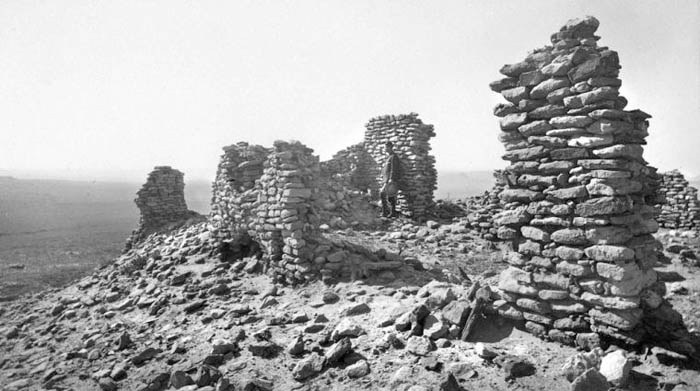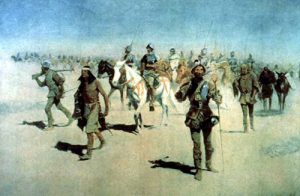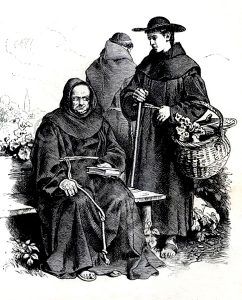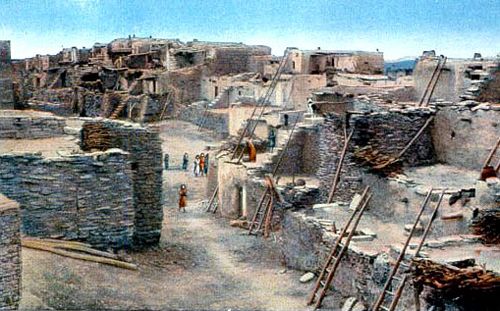The Awatovi Ruins in northeastern Arizona are an archaeological site on the Hopi Indian Reservation. The site contains the ruins of a pueblo estimated to be 500 years old and those of a 17th-century Spanish mission.
The Hopi pueblo of Awatovi was already over 300 years old when Spanish explorers arrived in 1540. Led by Francisco Vázquez de Coronado, the Spanish searched for the legendary golden cities of Cibola to bring wealth back to Spain. Instead, they found a harsh, arid country dotted with native towns in a region isolated from the populated Rio Grande Valley. The first of the Hopi settlements the Spanish came across in Arizona was the Awatovii pueblo. Years later, the Spanish returned to Awatovi to establish a mission.
The Coronado expedition left Mexico in 1540 and headed north with over 300 Spaniards, 1,300 Mexicans, and Native and African slaves. As they trekked through the desert, Coronado ordered one of his men, Pedro de Tovar, to lead a party of 17 horsemen and several footmen in search of seven Hopi villages. Awatovi was the first of these villages Tovar and his men discovered. Upon contact, the Hopi and Spanish briefly skirmished and then exchanged gifts before the de Tovar party moved on. The arrival of Coronado’s men in Awatovi marked the first exchange the Spanish had with the Hopi in Arizona. Afterward, contact between the Spanish and the Hopi was sporadic over the next 90 years, until Spain began to establish missions in the region to create a permanent European presence. The Hopi had no food surplus or wealth of gold or silver treasure. Their land was not a strategic place to establish a military presence, so the Spanish had no interest in living among the Hopi for any reason other than religious conversion.
During the Spanish colonial period, Jesuit and Franciscan missionaries brought Catholic and European values to North America on behalf of the Spanish crown. The Roman Catholic Church was charged with spreading Catholicism. The missionaries founded parishes near American Indian villages to make Christian converts, attempt to control the culture, and help administer Spanish law. In 1629, Spain launched large-scale missionary efforts in the Southwest, and Franciscans founded a mission church at Awatovi. The Franciscan fathers at Awatovi named their mission church San Bernard de Aguatubi, after Saint Bernard of Clairvaux.
According to New Mexico missionary records, the Franciscans at Awatovi struggled to persuade the Hopi to convert until a miracle occurred. The Hopi brought a blind boy to Father Francisco Porras and asked the father to heal him. The legend goes that Porras held his cross to the boy’s eyes, curing his blindness. Afterward, a large portion of the Hopi at Awatovi converted, but others mistrusted the Catholic fathers and worried that they would not keep their own essential rituals. During the 17th century, Awatovi hosted the largest mission of any Hopi pueblos and was home to roughly 900 Christian Hopi in 1664.
In addition to Catholicism, the Franciscans brought European tools, domesticated animals, new agriculture, and trade opportunities to their southwestern missions. At Awatovi, the fathers gave the Hopi iron knives, axes, mattocks, picks, crowbars, saws, chisels, and knowledge of Spanish wood and stone-working techniques. The Hopi also adopted animal husbandry. They acquired and began raising sheep, which provided a new protein and wool source for making textiles. The Spanish introduced new crops, including peaches and wheat, which the Hopi incorporated into their diet. The Hopi territory also became part of a trade route that a wagon train traveled through three times a year. This wagon train gave the Hopi at Awatovi access to goods from Mexico, Europe, and Asia.
The residents of Awatovi were an anomaly among the Hopi, and the town’s open acceptance of Christianity led to its destruction. Beyond Awatovi, other Hopi villages rejected Spanish culture and Catholicism. Only four missionary outposts existed in the Hopi province beyond Awatovi, and they did not have Catholic fathers in residence. The Awatovi Hopi built their new church on top of their kivas, adobe structures Puebloans used in spiritual rituals. Despite the apparent abandonment of the pre-contact religious practice, some native residents at Awatovi resisted the missionaries. A Hopi traditionalist poisoned one of the Awatovi mission’s founding fathers in 1633. During the Pueblo Revolt of 1680, the Hopi killed the fathers and razed the church at Awatovi.
Even so, when the Spanish returned to take back Awatovi in 1692, the Hopi welcomed them and invited them to reestablish the mission. Despite the instances of resistance on the inside, the anti-Spanish Hopi sacked the pueblo in 1701. These Hopi wanted to purge their province of Christianity and the Hopi who accepted it to ensure the survival of their own religious practices. They destroyed the pueblo and killed all the men at Awatovi during the attack sparing only the unbaptized women and children who knew Hopi rituals and songs. The survivors were separated and sent to the surrounding Hopi villages. In retaliation, the Spanish attacked the Hopi several times over the decade following the destruction of Awatovi but were unsuccessful in reclaiming the Hopi province. Since Awatovi, the Hopi have not hosted a Roman Catholic church or parish on their land.
In the 20th century, Awatovi proved to be a valuable archeological resource. During the 1930s, a group of experts from Harvard University carried out the first multidisciplinary study in American archeology at the ruin. Involved in the field study were geologists, surveyors, cartographers, photographers, bone and ceramics experts, artists, and ethno biologists. They excavated over 1,300 rooms, discovered 11,700 stone and bone artifacts, and cataloged 8,500 pottery specimens in addition to recording over half a million potsherds. They also identified three Franciscan churches, two of which were over 100 feet long. To preserve Awatovi Ruins for future research and enjoyment, the site is not open to the public.
Awatovi Ruins, a National Historic Landmark, is located south of Keams Canyon on the Hopi Indian Reservation in northeastern Arizona. Though the Hopi Reservation welcomes visitors, Awatovi Ruins is closed to the public.
Compiled & edited by Kathy Weiser/Legends of America, January 2021. Source – National Park Service.
Also See:
Ancient Cities of Native Americans




